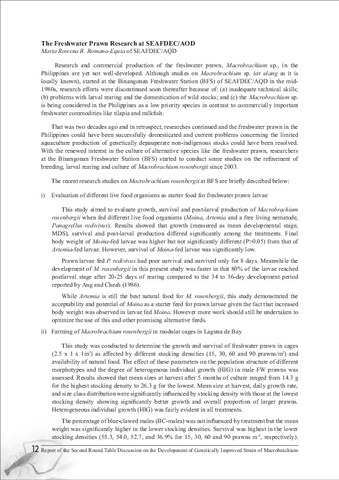The freshwater prawn research at SEAFDEC/AQD.
| dc.contributor.author | Eguia, Maria Rowena | |
| dc.date.accessioned | 2011-10-24T03:58:06Z | |
| dc.date.available | 2011-10-24T03:58:06Z | |
| dc.date.issued | 2005 | |
| dc.identifier.uri | http://hdl.handle.net/10862/675 | |
| dc.description.abstract | Research and commercial production of the freshwater prawn, Macrobrachium sp., in the Philippines are yet not well-developed. Although studies on Macrobrachium sp. (or ulang as it is locally known), started at the Binangonan Freshwater Station (BFS) of SEAFDEC/AQD in the mid-1980s, research efforts were discontinued soon thereafter because of: (a) inadequate technical skills; (b) problems with larval rearing and the domestication of wild stocks; and (c) the Macrobrachium sp. is being considered in the Philippines as a low priority species in contrast to commercially important freshwater commodities like tilapia and milkfish. That was two decades ago and in retrospect, researches continued and the freshwater prawn in the Philippines could have been successfully domesticated and current problems concerning the limited aquaculture production of genetically depauperate non-indigenous stocks could have been resolved. With the renewed interest in the culture of alternative species like the freshwater prawn, researchers at the Binangonan Freshwater Station (BFS) started to conduct some studies on the refinement of breeding, larval rearing and culture of Macrobrachium rosenbergii since 2003. | en |
| dc.language.iso | en | en |
| dc.publisher | Aquaculture Department, Southeast Asian Fisheries Development Center | en |
| dc.title | The freshwater prawn research at SEAFDEC/AQD. | en |
| dc.type | Meeting report | en |


